Zhuo Su
Parametric Gaussian Human Model: Generalizable Prior for Efficient and Realistic Human Avatar Modeling
Jun 07, 2025Abstract:Photorealistic and animatable human avatars are a key enabler for virtual/augmented reality, telepresence, and digital entertainment. While recent advances in 3D Gaussian Splatting (3DGS) have greatly improved rendering quality and efficiency, existing methods still face fundamental challenges, including time-consuming per-subject optimization and poor generalization under sparse monocular inputs. In this work, we present the Parametric Gaussian Human Model (PGHM), a generalizable and efficient framework that integrates human priors into 3DGS for fast and high-fidelity avatar reconstruction from monocular videos. PGHM introduces two core components: (1) a UV-aligned latent identity map that compactly encodes subject-specific geometry and appearance into a learnable feature tensor; and (2) a disentangled Multi-Head U-Net that predicts Gaussian attributes by decomposing static, pose-dependent, and view-dependent components via conditioned decoders. This design enables robust rendering quality under challenging poses and viewpoints, while allowing efficient subject adaptation without requiring multi-view capture or long optimization time. Experiments show that PGHM is significantly more efficient than optimization-from-scratch methods, requiring only approximately 20 minutes per subject to produce avatars with comparable visual quality, thereby demonstrating its practical applicability for real-world monocular avatar creation.
SEGA: Drivable 3D Gaussian Head Avatar from a Single Image
Apr 19, 2025Abstract:Creating photorealistic 3D head avatars from limited input has become increasingly important for applications in virtual reality, telepresence, and digital entertainment. While recent advances like neural rendering and 3D Gaussian splatting have enabled high-quality digital human avatar creation and animation, most methods rely on multiple images or multi-view inputs, limiting their practicality for real-world use. In this paper, we propose SEGA, a novel approach for Single-imagE-based 3D drivable Gaussian head Avatar creation that combines generalized prior models with a new hierarchical UV-space Gaussian Splatting framework. SEGA seamlessly combines priors derived from large-scale 2D datasets with 3D priors learned from multi-view, multi-expression, and multi-ID data, achieving robust generalization to unseen identities while ensuring 3D consistency across novel viewpoints and expressions. We further present a hierarchical UV-space Gaussian Splatting framework that leverages FLAME-based structural priors and employs a dual-branch architecture to disentangle dynamic and static facial components effectively. The dynamic branch encodes expression-driven fine details, while the static branch focuses on expression-invariant regions, enabling efficient parameter inference and precomputation. This design maximizes the utility of limited 3D data and achieves real-time performance for animation and rendering. Additionally, SEGA performs person-specific fine-tuning to further enhance the fidelity and realism of the generated avatars. Experiments show our method outperforms state-of-the-art approaches in generalization ability, identity preservation, and expression realism, advancing one-shot avatar creation for practical applications.
CoA: Towards Real Image Dehazing via Compression-and-Adaptation
Apr 08, 2025Abstract:Learning-based image dehazing algorithms have shown remarkable success in synthetic domains. However, real image dehazing is still in suspense due to computational resource constraints and the diversity of real-world scenes. Therefore, there is an urgent need for an algorithm that excels in both efficiency and adaptability to address real image dehazing effectively. This work proposes a Compression-and-Adaptation (CoA) computational flow to tackle these challenges from a divide-and-conquer perspective. First, model compression is performed in the synthetic domain to develop a compact dehazing parameter space, satisfying efficiency demands. Then, a bilevel adaptation in the real domain is introduced to be fearless in unknown real environments by aggregating the synthetic dehazing capabilities during the learning process. Leveraging a succinct design free from additional constraints, our CoA exhibits domain-irrelevant stability and model-agnostic flexibility, effectively bridging the model chasm between synthetic and real domains to further improve its practical utility. Extensive evaluations and analyses underscore the approach's superiority and effectiveness. The code is publicly available at https://github.com/fyxnl/COA.
RePerformer: Immersive Human-centric Volumetric Videos from Playback to Photoreal Reperformance
Mar 15, 2025Abstract:Human-centric volumetric videos offer immersive free-viewpoint experiences, yet existing methods focus either on replaying general dynamic scenes or animating human avatars, limiting their ability to re-perform general dynamic scenes. In this paper, we present RePerformer, a novel Gaussian-based representation that unifies playback and re-performance for high-fidelity human-centric volumetric videos. Specifically, we hierarchically disentangle the dynamic scenes into motion Gaussians and appearance Gaussians which are associated in the canonical space. We further employ a Morton-based parameterization to efficiently encode the appearance Gaussians into 2D position and attribute maps. For enhanced generalization, we adopt 2D CNNs to map position maps to attribute maps, which can be assembled into appearance Gaussians for high-fidelity rendering of the dynamic scenes. For re-performance, we develop a semantic-aware alignment module and apply deformation transfer on motion Gaussians, enabling photo-real rendering under novel motions. Extensive experiments validate the robustness and effectiveness of RePerformer, setting a new benchmark for playback-then-reperformance paradigm in human-centric volumetric videos.
EnvPoser: Environment-aware Realistic Human Motion Estimation from Sparse Observations with Uncertainty Modeling
Dec 13, 2024



Abstract:Estimating full-body motion using the tracking signals of head and hands from VR devices holds great potential for various applications. However, the sparsity and unique distribution of observations present a significant challenge, resulting in an ill-posed problem with multiple feasible solutions (i.e., hypotheses). This amplifies uncertainty and ambiguity in full-body motion estimation, especially for the lower-body joints. Therefore, we propose a new method, EnvPoser, that employs a two-stage framework to perform full-body motion estimation using sparse tracking signals and pre-scanned environment from VR devices. EnvPoser models the multi-hypothesis nature of human motion through an uncertainty-aware estimation module in the first stage. In the second stage, we refine these multi-hypothesis estimates by integrating semantic and geometric environmental constraints, ensuring that the final motion estimation aligns realistically with both the environmental context and physical interactions. Qualitative and quantitative experiments on two public datasets demonstrate that our method achieves state-of-the-art performance, highlighting significant improvements in human motion estimation within motion-environment interaction scenarios.
SMGDiff: Soccer Motion Generation using diffusion probabilistic models
Nov 25, 2024


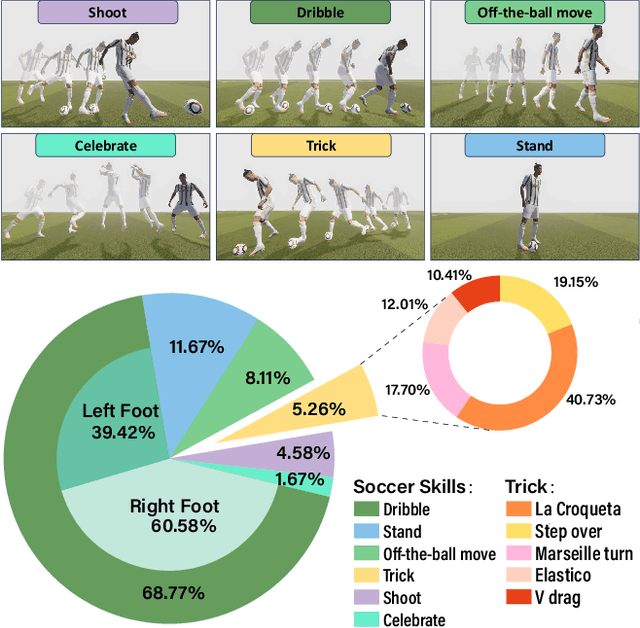
Abstract:Soccer is a globally renowned sport with significant applications in video games and VR/AR. However, generating realistic soccer motions remains challenging due to the intricate interactions between the human player and the ball. In this paper, we introduce SMGDiff, a novel two-stage framework for generating real-time and user-controllable soccer motions. Our key idea is to integrate real-time character control with a powerful diffusion-based generative model, ensuring high-quality and diverse output motion. In the first stage, we instantly transform coarse user controls into diverse global trajectories of the character. In the second stage, we employ a transformer-based autoregressive diffusion model to generate soccer motions based on trajectory conditioning. We further incorporate a contact guidance module during inference to optimize the contact details for realistic ball-foot interactions. Moreover, we contribute a large-scale soccer motion dataset consisting of over 1.08 million frames of diverse soccer motions. Extensive experiments demonstrate that our SMGDiff significantly outperforms existing methods in terms of motion quality and condition alignment.
EMHI: A Multimodal Egocentric Human Motion Dataset with HMD and Body-Worn IMUs
Aug 30, 2024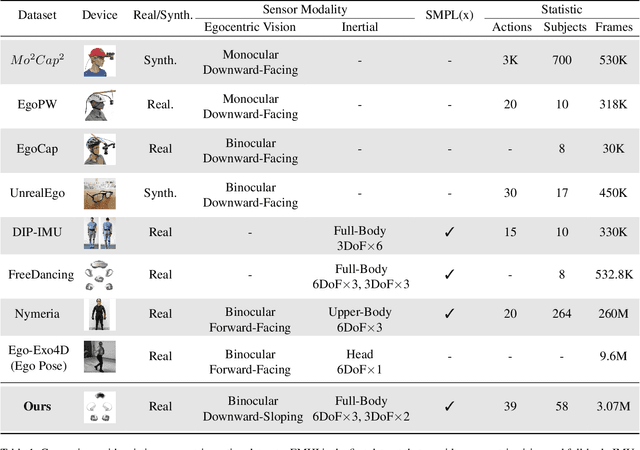
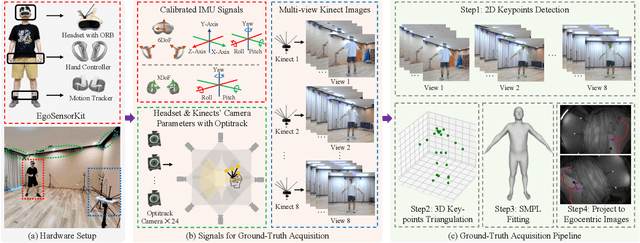


Abstract:Egocentric human pose estimation (HPE) using wearable sensors is essential for VR/AR applications. Most methods rely solely on either egocentric-view images or sparse Inertial Measurement Unit (IMU) signals, leading to inaccuracies due to self-occlusion in images or the sparseness and drift of inertial sensors. Most importantly, the lack of real-world datasets containing both modalities is a major obstacle to progress in this field. To overcome the barrier, we propose EMHI, a multimodal \textbf{E}gocentric human \textbf{M}otion dataset with \textbf{H}ead-Mounted Display (HMD) and body-worn \textbf{I}MUs, with all data collected under the real VR product suite. Specifically, EMHI provides synchronized stereo images from downward-sloping cameras on the headset and IMU data from body-worn sensors, along with pose annotations in SMPL format. This dataset consists of 885 sequences captured by 58 subjects performing 39 actions, totaling about 28.5 hours of recording. We evaluate the annotations by comparing them with optical marker-based SMPL fitting results. To substantiate the reliability of our dataset, we introduce MEPoser, a new baseline method for multimodal egocentric HPE, which employs a multimodal fusion encoder, temporal feature encoder, and MLP-based regression heads. The experiments on EMHI show that MEPoser outperforms existing single-modal methods and demonstrates the value of our dataset in solving the problem of egocentric HPE. We believe the release of EMHI and the method could advance the research of egocentric HPE and expedite the practical implementation of this technology in VR/AR products.
HeadGAP: Few-shot 3D Head Avatar via Generalizable Gaussian Priors
Aug 12, 2024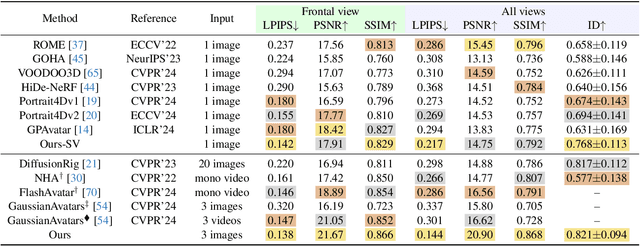
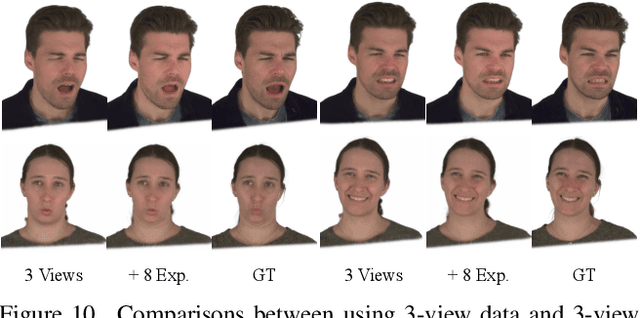


Abstract:In this paper, we present a novel 3D head avatar creation approach capable of generalizing from few-shot in-the-wild data with high-fidelity and animatable robustness. Given the underconstrained nature of this problem, incorporating prior knowledge is essential. Therefore, we propose a framework comprising prior learning and avatar creation phases. The prior learning phase leverages 3D head priors derived from a large-scale multi-view dynamic dataset, and the avatar creation phase applies these priors for few-shot personalization. Our approach effectively captures these priors by utilizing a Gaussian Splatting-based auto-decoder network with part-based dynamic modeling. Our method employs identity-shared encoding with personalized latent codes for individual identities to learn the attributes of Gaussian primitives. During the avatar creation phase, we achieve fast head avatar personalization by leveraging inversion and fine-tuning strategies. Extensive experiments demonstrate that our model effectively exploits head priors and successfully generalizes them to few-shot personalization, achieving photo-realistic rendering quality, multi-view consistency, and stable animation.
HumanSplat: Generalizable Single-Image Human Gaussian Splatting with Structure Priors
Jun 18, 2024Abstract:Despite recent advancements in high-fidelity human reconstruction techniques, the requirements for densely captured images or time-consuming per-instance optimization significantly hinder their applications in broader scenarios. To tackle these issues, we present HumanSplat which predicts the 3D Gaussian Splatting properties of any human from a single input image in a generalizable manner. In particular, HumanSplat comprises a 2D multi-view diffusion model and a latent reconstruction transformer with human structure priors that adeptly integrate geometric priors and semantic features within a unified framework. A hierarchical loss that incorporates human semantic information is further designed to achieve high-fidelity texture modeling and better constrain the estimated multiple views. Comprehensive experiments on standard benchmarks and in-the-wild images demonstrate that HumanSplat surpasses existing state-of-the-art methods in achieving photorealistic novel-view synthesis.
HMD-Poser: On-Device Real-time Human Motion Tracking from Scalable Sparse Observations
Mar 06, 2024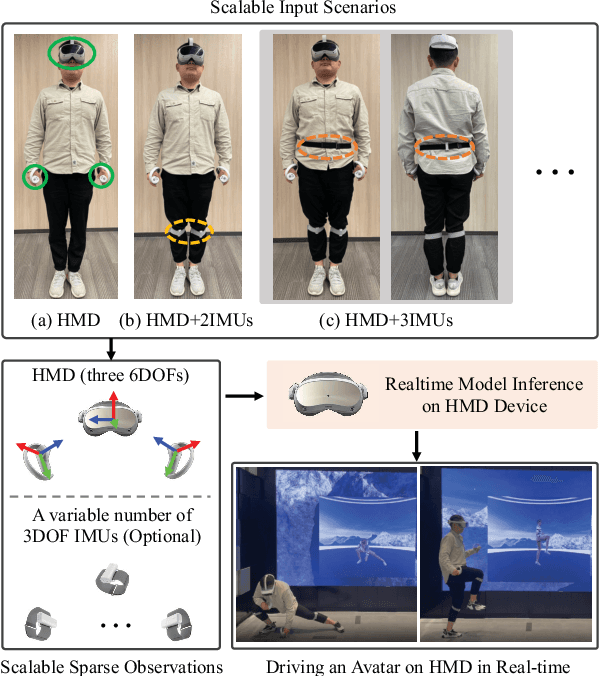

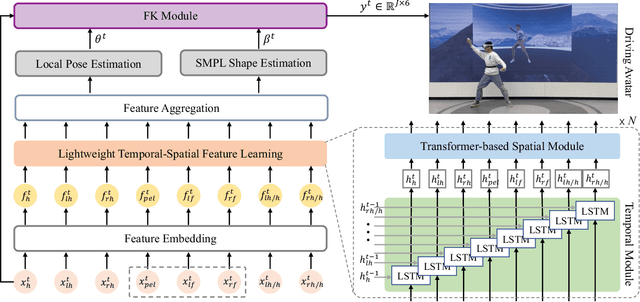

Abstract:It is especially challenging to achieve real-time human motion tracking on a standalone VR Head-Mounted Display (HMD) such as Meta Quest and PICO. In this paper, we propose HMD-Poser, the first unified approach to recover full-body motions using scalable sparse observations from HMD and body-worn IMUs. In particular, it can support a variety of input scenarios, such as HMD, HMD+2IMUs, HMD+3IMUs, etc. The scalability of inputs may accommodate users' choices for both high tracking accuracy and easy-to-wear. A lightweight temporal-spatial feature learning network is proposed in HMD-Poser to guarantee that the model runs in real-time on HMDs. Furthermore, HMD-Poser presents online body shape estimation to improve the position accuracy of body joints. Extensive experimental results on the challenging AMASS dataset show that HMD-Poser achieves new state-of-the-art results in both accuracy and real-time performance. We also build a new free-dancing motion dataset to evaluate HMD-Poser's on-device performance and investigate the performance gap between synthetic data and real-captured sensor data. Finally, we demonstrate our HMD-Poser with a real-time Avatar-driving application on a commercial HMD. Our code and free-dancing motion dataset are available https://pico-ai-team.github.io/hmd-poser
 Add to Chrome
Add to Chrome Add to Firefox
Add to Firefox Add to Edge
Add to Edge